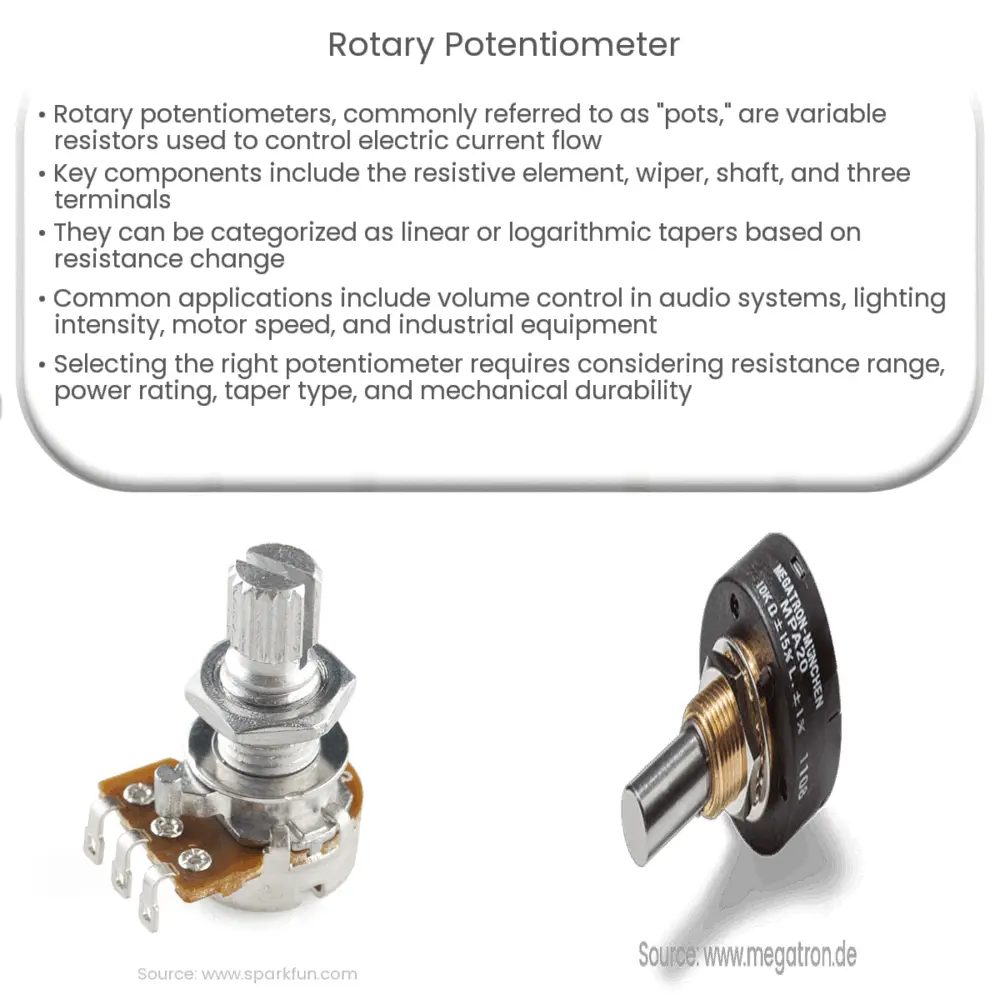A rotary potentiometer is a variable resistor with a rotating knob, used to control voltage, volume, or speed in various electronic devices.

Understanding the Rotary Potentiometer: A Comprehensive Guide
Introduction
A rotary potentiometer is an essential component in various electronic devices, as it allows for adjustable resistance and control over various applications. This versatile component has been widely used in applications like volume control in audio systems, lighting control, and many other scenarios where precise adjustments are required. In this article, we will delve into the fundamental aspects of rotary potentiometers, including their design, functionality, and common applications.
What is a Rotary Potentiometer?
A rotary potentiometer, often referred to simply as a “pot,” is a three-terminal electronic component that functions as a variable resistor. Its primary purpose is to control the flow of electric current by adjusting the resistance between its terminals. When the knob or shaft of the potentiometer is turned, it changes the position of a wiper that slides along a resistive element, resulting in a change in resistance between the wiper and the other two terminals.
Components of a Rotary Potentiometer
Rotary potentiometers are composed of several key parts that work together to provide adjustable resistance. These main components include:
- Resistive Element: This is the primary component that determines the overall resistance range of the potentiometer. Typically made from materials like carbon, cermet, or conductive plastic, the resistive element forms a circular or semi-circular path that the wiper moves along.
- Wiper: The wiper, also known as the slider, is a movable contact that slides along the resistive element when the shaft or knob is turned. As the wiper moves, it alters the resistance between the terminals.
- Shaft: The shaft is the part of the potentiometer that is turned by the user to adjust the resistance. It is connected to the wiper and is usually designed to accept a knob for easier manipulation.
- Terminals: A rotary potentiometer has three terminals. Two of these are connected to the resistive element, while the third is connected to the wiper. By measuring the voltage across different combinations of terminals, the potentiometer’s resistance can be determined.
Types of Rotary Potentiometers
Rotary potentiometers can be classified into various types based on several factors, such as their design, material, and intended use. Some common types include:
- Linear Taper: In a linear taper potentiometer, the resistance changes linearly as the wiper moves along the resistive element. This type is commonly used in applications where a direct relationship between the knob position and output is desired.
- Logarithmic Taper: Also known as an audio taper potentiometer, the resistance in this type changes logarithmically as the wiper moves. This type is typically used in audio applications, as it provides a more natural and gradual change in volume.
Applications of Rotary Potentiometers
Rotary potentiometers have a wide range of applications in various industries, thanks to their versatility and ease of use. Some common applications include:
- Volume Control: One of the most common uses of rotary potentiometers is in audio systems for controlling volume levels. Logarithmic taper potentiometers are typically used in this application, as they provide a more natural and gradual change in volume.
- Lighting Control: Rotary potentiometers can also be used in lighting systems to control the intensity of light sources. By adjusting the resistance, the amount of current passing through the light source can be varied, resulting in different levels of brightness.
- Motor Speed Control: In certain motor control applications, rotary potentiometers can be used to adjust the speed of the motor. By changing the resistance, the voltage across the motor can be controlled, which in turn adjusts the speed of the motor.
- Industrial Equipment: Rotary potentiometers are often used in industrial equipment to provide precise control over various processes. Examples include controlling the speed of conveyor belts or adjusting the position of robotic arms.
Selecting the Right Rotary Potentiometer
When choosing a rotary potentiometer for a specific application, several factors need to be considered. These include:
- Resistance Range: The overall resistance range of the potentiometer should be appropriate for the application. Consider the minimum and maximum resistance values required and select a potentiometer that falls within this range.
- Power Rating: Ensure that the potentiometer’s power rating is suitable for the intended application. The power rating indicates the maximum amount of power the potentiometer can dissipate without being damaged.
- Taper Type: Depending on the desired output relationship, choose either a linear or logarithmic taper potentiometer. Linear tapers provide a direct relationship between knob position and output, while logarithmic tapers offer a more gradual change.
- Mechanical Durability: The mechanical durability of the potentiometer should also be taken into account, especially for applications that require frequent adjustments. Potentiometers with higher rotational life cycles are more suitable for such applications.
Conclusion
Rotary potentiometers are versatile and widely used electronic components that offer adjustable resistance in various applications. By understanding their fundamental aspects, including design, functionality, and types, users can make informed decisions when selecting the right potentiometer for their specific needs. With proper selection and usage, rotary potentiometers can greatly enhance the functionality and user experience of electronic devices and systems.

